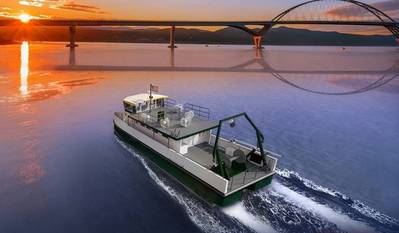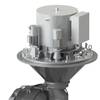University of Vermont Orders Hybrid-electric Research Vessel
The University of Vermont has ordered a new research vessel featuring an emissions-reducing electric power and propulsion system.
The 64-foot aluminum catamaran, designed by Chartwell Marine and currently under construction at Derecktor Shipyards, will be equipped with a hybrid-electric power and propulsion system supplied and integrated by BAE Systems. The newbuilt is set for launch in April 2022.
According to BAE Systems, its HybriGen Power and Propulsion system will help reduce both carbon emissions and the use of fuel by the vessel, which will serve as a floating classroom and lab for students of the Rubenstein School of Environment and Natural Resources conducting research on Lake Champlain.
“Using green energy to power transportation in the water is an essential part of establishing cleaner waterways and harbors in places where we live, work, and visit,” said Steve Trichka, vice president and general manager of Power & Propulsion Solutions at BAE Systems. “This proven and reliable technology will create a new and sustainable way for the University of Vermont to conduct its critical research.”
With two AC electric motors, backed up by two 306-horse-power diesel engines, the vessel will be able to run on all-electric power for trips under two hours. The fully integrated HybriGen Power and Propulsion system includes electric motors, variable speed generators, battery-based energy storage system, and vessel auxiliary power with shore power charging. The technology creates a clean form of power and propulsion for the vessel and its auxiliary power needs such as heat, air conditioning, lighting, and working deck gear. The electric-powered components not only provide emission-reducing benefits to the environment, but also create a smooth ride for passengers and help operators save on maintenance costs, the manufacturer said.
The new vessel is part of a shift in boat design in an age of climate change and other environmental concerns. “The future of vessel procurement will look quite different to its current form today, as operators worldwide begin to respond to increasingly stringent requirements for low-emission craft,” said Andy Page, naval architect and managing director for Chartwell Marine.
Derecktor Shipyards brings to the project experience in the development and construction of hybrid vessels, “and this will be our fourth such build,” said Justin Beard, a manager for Derecktor. “While the concept is similar to previous builds, this particular vessel includes berth space, as well as more dedicated space for research,” he said. “The finished product will be a truly unique research vessel built to foster the education of future scientists and engineers.”
The newbuild will also house a unique new winch system for research trawling and plankton nets. The direct-drive winches will enable UVM scientists and staff to operate more efficiently than ever before and can be operated using a single wireless joystick. This compact system was developed by engineers at the Woods Hole Oceanographic Institution and is being brought to market by InterOcean Systems of San Diego, Calif., for UVM. This will be the first vessel in the world to use this technology.
UVM researchers on Lake Champlain carry out a wide range of science missions from restoring local lake trout populations to probing global climate change. The vessel will serve as a science platform while also providing a floating classroom for UVM classes, as well as middle school, high school and public groups taking part in NOAA’s Sea Grant Watershed Alliance education program. To meet both needs, the new vessel has a large interior lab and accessible teaching space—and is being constructed as a US Coast Guard-inspected passenger vessel.
The new research vessel will replace the university’s aging research boat, Melosira, and will be housed at UVM’s Rubenstein Ecosystem Sciences Laboratory, located in the Leahy Center for Lake Champlain, on the shore of Lake Champlain in downtown Burlington. The university is grateful for the steadfast advocacy that Sen. Patrick Leahy has shown in supporting UVM scientific research for the benefit of Vermont and Vermonters. His commitment to the preservation of water quality in the Lake Champlain watershed is unparalleled, and his stewardship of this project will allow researchers at UVM to continue this important work well into the future.












